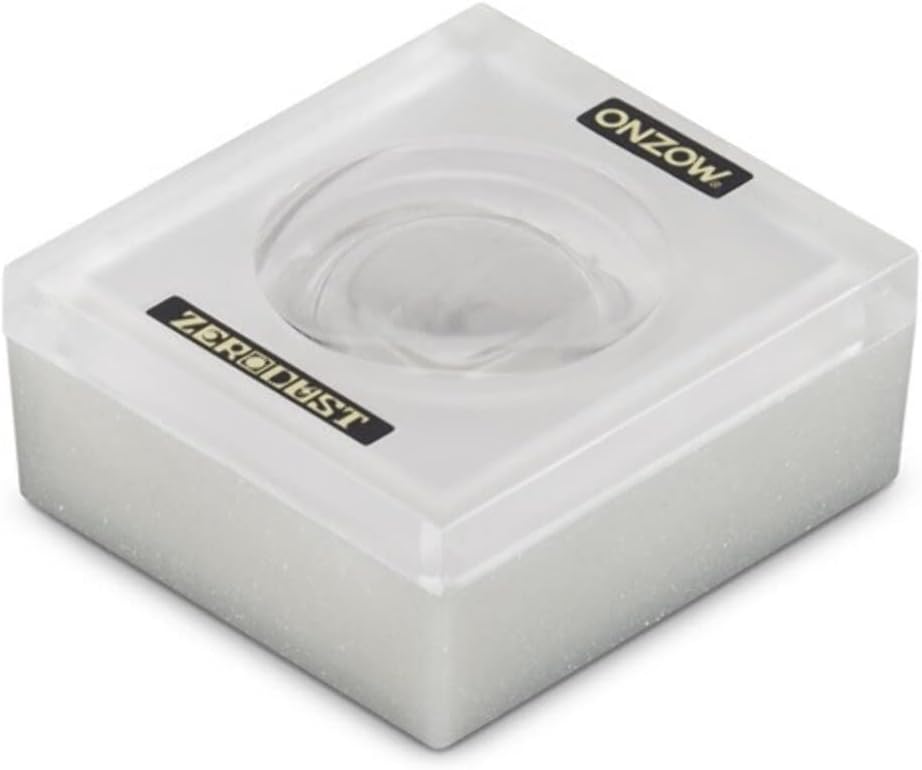Onzow Issues a New Instruction For the Zero Dust
a multi-year, multi-website epic ends here (even though I thought it concluded May 1st)
Last May 1st, Tracking Angle published "The Onzow Zerodust Controversy Concludes Here" in which I thought we'd put the story forever to rest. I thought "everyone" would be satisfied by the instructions published there. Please read them using the above hyperlink.
Later Onzo Labs' Akira Ishibashi requested that I remove the original photo we'd been using to show the residue left on the stylus, to one more representative of what WAM Engineering's J.R. Boisclair found using his microscope, rather than the "worst case scenario" shown in that photo. So I did that and thought "case closed".
The new instructions cover everything a Zerodust user needs to know about safe use and avoiding leaving a residue on the stylus. Or so I thought.
However, the other day a new email arrived from Mr. Ishibashi. Among the contents of his email was this:
"I see malicious intent in your words on the new article, and from keeping and replacing a picture to try to prove that your original post "Time to Put Away The Onzow ZeroDust" was not wrong, which is shown in this sentence;
(Removing the residue was difficult and time consuming. Not everyone using the Zerodust reported finding this residue, so what exactly was causing it for some and not for others? Rather than going into the long explanation of how and what was discovered and why, here are the new Zerodust instructions that both explain what happened and how to prevent it from ever again happening.)
When you say 'fact based“reporting”', we never saw any report after 2 years which proves that it came from our product."
Mr. Ishibashi claims I don't care about "loss, damage, and suffering" caused by my reporting. That's unfair of course. As would be my claim were I to make it, which I'm not, that the company doesn't care about the possible loss, damage, and suffering caused by the product to the end user.
The company now claims there's no "proof" that the residue came from the product. Boisclair insisted to me over the phone just a few minutes before I wrote this, that he's found the residue only on cartridges supplied to him for inspection where the customer has used the Onzow Zerodust. What's more, the residue has been identified and results from a breakdown of the product. The only unanswered question, he told me, was why it broke down. He said a new Zerodust sent by the company to him did not leave any residue.
This is after J.R. Boisclair and Onzow had been in frequent communication and there clearly was sufficient evidence to show from where the residue came and why, though I was not privy to the communications.
In his recent email to me Mr. Ishibashi repeats what was published in the May 1st story:
"If we go back to the instructions you announced on May 1st, 'The Onzow Zerodust Controversy Concludes Here':
(A) Do not expose ZERODUST to high temperatures or direct sunlight.
(There is a possibility of deterioration.)
(B) Keep ZERODUST in a safe place and close the lid when not in use.
ZERODUST does not stick to the stylus unless it may deteriorate.
(C) Replace your ZERODUST after 3 years from the date from your purchase date."I thought that settled it!
He then writes:
Instruction (A) was already included from the original instruction manual.
(C) is the only new notice, and yet after careful examination with our laboratory, I decided to extend it to 7 years. (Italics added by MF).He went on:
"I want you to remove this post and create a new one to inform the readers that:
- 1 (A) was already in ONZOW's instruction, and it was a simple reminder.
- 2 After careful examination, ONZOW decided to extend the shelf life of ZERODUST to 7 years with careful use.
Although I recommend changing it more frequently for heavy users."
I am happy to create a new post (this one) informing Tracking Angle readers that you should follow instructions A) and B) that were always in the instructions, and that Onzow now says you can use the Zerodust for 7 years, not the previously recommended 3, (though heavy users should change it more often). Done.
However I am not removing the May 1st post. Instead I'll update it with the extended time recommendation.
So to reiterate: as of May 1st (C) was the only new notice— and I think it was an important addition to the instructions so buyers can safely use the Zerodust and not risk getting the residue on their stylus. And I thought "case closed". I thought this was a good outcome for both the company and for readers who want to buy and use a Zerodust.
Now Mr. Ishibashi claims "we never saw any report after 2 years which proves that it came from our product." And that he's extending the safe use time from 3 to 7 years.
Readers, please draw your own conclusion.
Mine is that the Zerodust is safe to use if you follow the instructions A) and B) and replace the $40 Zerodust every 3 years just to be on the safe side.
Mr. Ishibashi's is that there's no proof the residue came from his product and that if you follow all instructions it's safe for 7 years—unless you are "heavy user".
Is everybody happy?










































.png)








